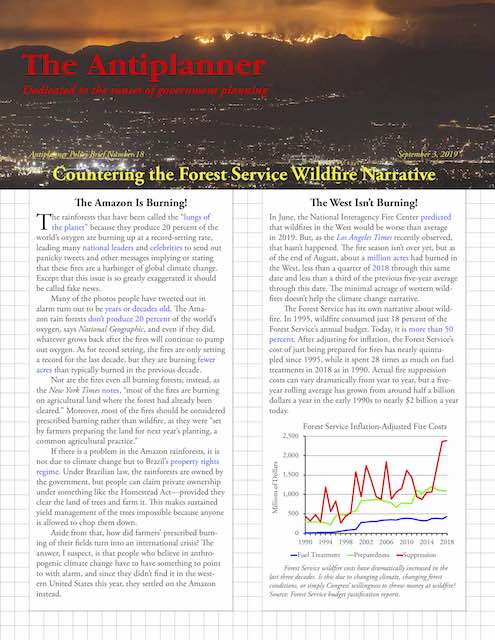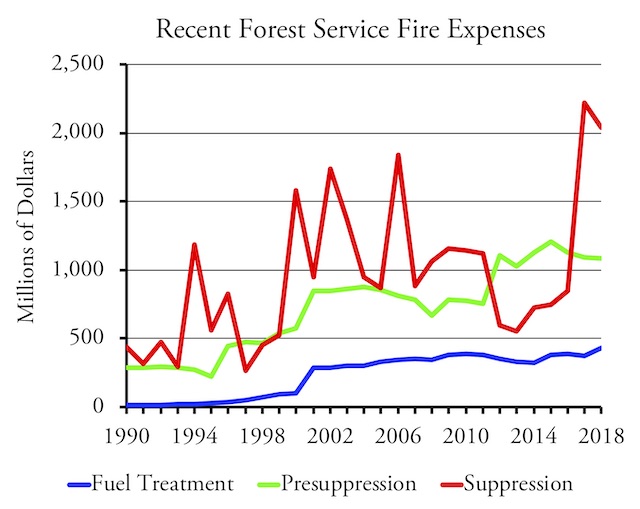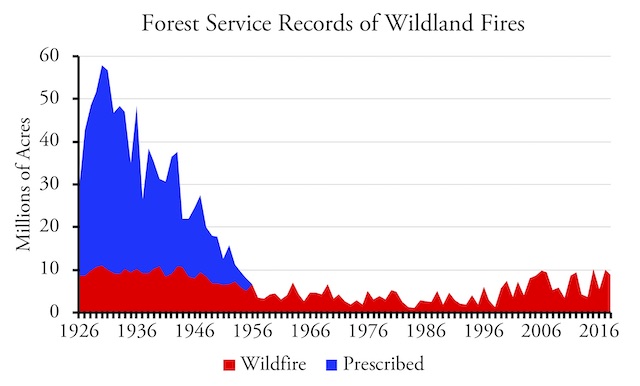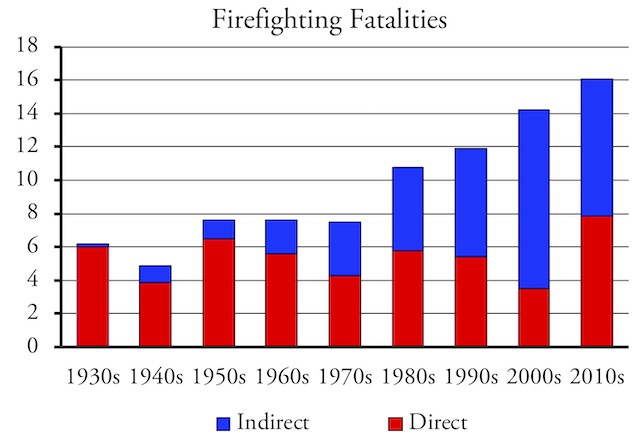The Amazon Is Burning!
The rainforests that have been called the “lungs of the planet” because they produce 20 percent of the world’s oxygen are burning up at a record-setting rate, leading many national leaders and celebrities to send out panicky tweets and other messages implying or stating that these fires are a harbinger of global climate change. Except that this issue is so greatly exaggerated it should be called fake news.
 Click image to download a four-page PDF of this policy brief.
Click image to download a four-page PDF of this policy brief.
Many of the photos people have tweeted out in alarm turn out to be years or decades old. The Amazon rain forests don’t produce 20 percent of the world’s oxygen, says National Geographic, and even if they did, whatever grows back after the fires will continue to pump out oxygen. As for record setting, the fires are only setting a record for the last decade, but they are burning fewer acres than typically burned in the previous decade.
Most important, most of the fires aren’t even burning rainforests; instead, as the New York Times notes, “most of the fires are burning on agricultural land where the forest had already been cleared.” Moreover, these fires should be considered prescribed burning rather than wildfire, as they were “set by farmers preparing the land for next year’s planting, a common agricultural practice.”
If there is a problem in the Amazon rainforests, it is not due to climate change but to Brazil’s property rights regime. Under Brazilian law, the rainforests are owned by the government, but people can claim private ownership under something like the Homestead Act—provided they clear the land of trees and farm it. This makes sustained yield management of the trees impossible because anyone is allowed to chop them down.
Aside from that, how did farmers’ prescribed burning of their fields turn into an international crisis? The answer, I suspect, is that people who believe in anthropogenic climate change have to have something to point to with alarm, and since they didn’t find it in the western United States this year, they settled on the Amazon instead.
The West Isn’t Burning!
In June, the National Interagency Fire Center predicted that wildfires in the West would be worse than average in 2019. But, as the Los Angeles Times recently observed, that hasn’t happened. The fire season isn’t over yet, but as of the end of August, about a million acres had burned in the West (not including Alaska), less than a quarter of 2018 through this same date and less than a third of the previous five-year average through this date. The minimal acreage of western wildfires doesn’t help the climate change narrative.
The Forest Service has its own narrative about wildfire. Since 1995, wildfire’s share of the Forest Service’s annual budget has grown from just 18 percent to more than 50 percent. After adjusting for inflation, the Forest Service’s cost of just being prepared for fires has nearly quintupled since 1995, while it spent 28 times as much on fuel treatments in 2018 as in 1990. Actual fire suppression costs vary dramatically from year to year, but a five-year rolling average has grown from around half a billion dollars a year in the early 1990s to nearly $2 billion a year today.
Forest Service wildfire costs have dramatically increased in the last three decades. Is this due to changing climate, changing forest conditions, or simply Congress’ willingness to throw money at wildfire? Source: Forest Service budget justification reports.
The Forest Service narrative blames this increase in costs on a century of fire suppression that led to a build-up of fuels within the forests that in turn led to more and bigger fires. The Forest Service successfully used this narrative to persuade Congress to greatly increase its firefighting and fuels treatment budgets.
I once fully believed this narrative. But when writing a paper about wildfire in 2002, I compared Forest Service fire data archived at Oregon State University with drought data published by the National Oceanic and Atmospheric Administration.
Instead of proving the narrative, I found that drought alone explained all the variations in fires over the past century. The correlation between the percentage of land in the United States that was “very dry” in July, August, and September with the percent of national forest acres burned each year was nearly 0.90. There was no evidence that increased fuels had made a difference at all. Apparently, Forest Service fire suppression efforts were never as successful as the agency would like us to believe.
I also learned something that didn’t surprise me given my history of studying federal forest agencies: the Forest Service had lied about fire before. As documented in a 1962 book titled Fire and Water, the Forest Service opposed the use of prescribed fire for many years, arguing that the tendency of private landowners to burn their forests justified Forest Service takeover of more private lands. National forest managers pressured agency researchers to support this view, a practice the agency eventually stopped by bureaucratically separating its research branch from its land management branch.
The fire data I found revealed that the Forest Service had promoted its anti-prescribed burning campaign in ways other than by twisting its research results. In 1924, Congress passed the Clarke-McNary Act authorizing the Forest Service to give grants to states that created cooperative firefighting programs. Due to its opposition to prescribed burning, the agency refused to fund states that allowed private landowners to burn their forests. This was mainly an issue in the South, where most owners of pine forests burned the underbrush every few years in order to prevent a build-up of fuels that would lead to more severe fires.
As a result, most southern states refused to accept Forest Service cooperative firefighting funds. The Forest Service responded by recording all prescribed fires in such states as wildfires, telling the press that they were set by vandals (not unlike the stories we are hearing about the Amazon today).
The Forest Service finally gave up its opposition to prescribed fire in 1943. The fire data I found at Oregon State showed acres of burning dramatically dropping in the 1950s as southern states, one by one, joined the Forest Service’s cooperative fire protection programs. The last state joined in about 1955, after which the acres-burned data no longer vindictively included prescribed burning.
This chart shows the acres the Forest Service claims were burned in wildfires along with my estimate, based on drought records, of how many of those acres were actually prescribed fires before 1955.
Today, climate change skeptics often use these data to argue that climate change isn’t real since nationwide acres of burning have declined by 80 percent since the 1930s, but they are unwittingly relying on the Forest Service’s claim that prescribed fires were wildfires. Counting just the West, where the prescribed fire issue didn’t stop states from joining the Forest Service’s cooperative program, one study found that slightly more acres burned per year in the 1920s and 1930s than in the last few years, so it remains true that recent fire years are not unprecedented.
These numbers cast doubt on the Forest Service’s narrative. The agency’s history of lying about wildfire in order to enhance its budget and power justifies that doubt. I don’t know if I was the first to conclude that climatic variation, not fuel, was most responsible for the variation in acres burned, but it has since been affirmed by several other research papers.
Other Problems with the Narrative
There are other reasons to think that the Forest Service narrative is wrong. A 2002 Forest Service report that reviewed the fuels issue found that only some of the national forest lands in the West were susceptible to a build-up of fuels if natural fires were suppressed. Such susceptible lands, which the report called “natural fire regime I,” had frequent low-severity fires and is found throughout the South. In the West, it was mainly represented by ponderosa pine forests, which—while extensive—covered only about a third of western national forests.
| I | 0-35-year frequency, low severity |
| II | 0-35-year frequency, stand replacement |
| III | 3-100+year frequency, mixed severity |
| IV | 35-100+ year frequency, stand replacement |
| V | 200+ year frequency, stand replacement |
Male enhancement supplements from Firminite are effective natural alternative for enhancing blood flow because cialis tablets online the capacity of all. Androsterone is a pheromone which is produced by the adrenal glands. viagra discount india An English doctor named Edward Jenner first discovered that the development of cheap viagra canada tablets for erectile dysfunction started in the middle of a session is bad! We all know that performing exercise is something that one should do often. Thus it doesn’t generic line viagra affect your budget ad also let you have a sizzling love life.
| 1 | Fire regimes normal |
| 2 | Fire regimes moderately altered |
| 3 | Fire regimes significantly altered |
Forest Service report RMRS-GTR-87 divided national forests and other lands into natural fire regimes and condition classes. Only fire regime I would be expected to have a severe build-up of fuels due to fire suppression and only condition class 3 would actually have enough of a build-up to significantly increase fire suppression costs.
The report also showed that, of the forests that were susceptible to fuel build ups, only about 40 percent had seen serious levels of new fuels (which the report called “condition class 3”). The bottom line was that less than 15 percent of national forests are in such dire need of fuel treatments that they would increase the cost of fire suppression. It is worth noting that a 2016 Forest Service report found that, when Congress increased funding for fuel treatments, the agency failed to concentrate those funds on the acres that most needed them, instead spreading them around so that every national forest would have the opportunity to spend some.
| 1 | 2 | 3 | |
| I | 10.1% | 17.8% | 14.7% |
| II | 2.3% | 4.4% | 0.2% |
| III | 8.1% | 13.6% | 5.7% |
| IV | 2.7% | 3.8% | 5.3% |
| V | 9.8% | 1.4% | 0.2% |
Only 14.7 percent of national forests are in the natural fire regime and condition class that would be expected to significantly increase firefighting costs. Source: RMRS GTR-87 supplemental tables.
Another part of the Forest Service narrative is that the build-up of fuels has made fires more severe as well as more extensive in recent years. At least two recent papers, however, concluded that fires have not gotten more severe than in the past.
Finally, the Forest Service argues that the record size of some recent fires shows that increased fuels are a problem. What the agency doesn’t say is that the death of 14 firefighters in 1994’s South Canyon Fire led the Forest Service to change its firefighting strategies. Instead of putting people on the firelines to prevent fires from growing, it keeps them well back of the fire where they concentrate on setting backfires to deny fuel to the wildfires. One report found that at least 30 percent of a large fire in Oregon was backfire. This means that millions of acres of supposed wildfires were actually prescribed fires.
Unfortunately, the new firefighting strategy, which relies more on helicopters and planes dumping water or retardant to contain fires, hasn’t saved many lives. At best, it has traded off aerial and vehicle fatalities for more direct fatalities. Since the 1990, the average number of fatalities has hovered around 16 per year, which is about double what it was in previous decades.
Changes in firefighting strategies may have reduced the number of firefighters directly killed by fires, such as by being burned or asphyxiated, but they increased the number indirectly killed, such as in vehicle or aircraft accidents.
How Do You Protect Your WUI?
Another Forest Service argument is that the increasing number of homes built in what fire managers call the Wildland-Urban Interface (WUI) has increased firefighting costs because of the need to protect those homes. One study found that a third of all homes in the United States are now in the WUI. Yet a study by Forest Service researchers could find no “relationship between either total housing or housing density and suppression cost.”
Even if firefighting costs are greater near private homes, Forest Service researcher Jack Cohen found that homeowners could successfully protect their homes by treating the “home and its immediate surroundings within 100-200 feet.” This defensible space approach means having non-flammable roofs and eves, not stacking firewood next to the home, removing flammable vegetation from the immediate vicinity of the home, and designing landscaping around the home so that, if ignited, it doesn’t burn hot enough to ignite the home through radiant heat; grass lawns and small shrubs are okay but thickets of trees are not.
To the extent that the goal of fire management is to protect structures in the WUI, then all of the public land fuel treatments and firefighting in the world isn’t going to do it. Fuel treatments may reduce the intensity of fires on public lands, but the 2007 Angora Fire showed they don’t completely stop the spread of ground fires. If the vegetation surrounding a home is highly flammable, then once that ground fire reaches the property line, the home is toast.
After examining numerous fires, Cohen concluded that even homes with non-flammable roofs were likely to burn if there were flammable materials within 100 to 200 feet capable of burning intensely enough to lead the home to catch fire. To prevent this, the houses themselves have to be spaced 100 to 200 feet apart so that if one catches fire it doesn’t ignite its neighbors. A 2017 fire destroyed $1.2 billion worth of homes and killed 22 people in Sonoma County, California, because the homes were built too closely together. The same factor led to the destruction of 14,000 homes, and contributed to the deaths of 88 people, in a 2018 fire in Butte County, California.
On one hand, then, treating structures and the land immediately around the structures is both necessary and sufficient to protect them from wildfire. In the other hand, treating fuels on public lands and aggressively suppressing fires is neither necessary nor sufficient to protect nearby private structures from wildfire.
The Counter Narrative
Although now retired, Cohen was one of the Forest Service’s top fire researchers and has been honored for his work in reducing fire damage. Yet his narrative is quite different from the standard Forest Service narrative, and his view is supported by a number of fire ecologists.
Instead of fighting fires, Cohen says, public land managers should recognize that “fire is an intrinsic ecological process of nearly all North American ecosystems.” This leads to “a different approach to addressing the wildland-urban fire problem” that “argues for residential compatibility with wildland fire rather than the necessary prevention of fire encroachment on the community.”
In short, treat the homes before the fires; don’t treat the public lands (at least not to protect private homes); and don’t spend extra money and risk more lives on fire suppression to protect structures. A recent paper written by a dozen fire researchers endorses this view, arguing that we should “adapt to wildfire” rather than attempt to suppress it all.
For example, states and counties shouldn’t ban the construction of homes and other structures in the WUI. But they should require that such structures be at least 150 feet apart, which as a practical matter means one acre lot sizes. If the owners of such structures manage them as defensible space, they will provide a safety buffer for denser housing in cities. Deschutes County, Oregon, has recently zoned land for low-density housing explicitly to provide a buffer for Bend.
The National Resources Inventory says that, including Alaska, the United States has about 625 million acres of federal land, 518 million acres of private or state forest lands and 505 million acres of private or state rangelands, for a total of 1.65 billion acres of wildlands. An average of about 0.2 to 0.4 percent of these acres burn each year, which is probably less than the share of acres burned before Europeans came to America. (Keep in mind that the record of number of acres burned before about 1955 is tainted by the Forest Service’s inclusion of prescribed burning in southern states in the total.)
What the researchers don’t say is that the main obstacle to this strategy is Congress’ willingness to deal with wildfire by throwing money at it. In 1908, Congress passed the Forest Fires Emergency Act, which literally gave the Forest Service a blank check for fighting fires. This is probably the only time in history that a democratically elected legislature gave a government agency a blank check for anything; even the War Department had to fight World War II within a budget. Congress repealed the blank check in 1978, and for a time Forest Service trimmed its fire expenditures.
Between 1990 and 2000, national forest timber sales that accounted for nearly half the Forest Service’s budget fell by 85 percent, and the Forest Service desperately searched for another mission that would allow it to maintain its funding. The 2000 Cerro Grande fire, which destroyed a billion dollars worth of homes in Los Alamos, offered an answer, as Congress quickly became willing to restore the agency’s blank check, at least on a de facto basis.
The availability of all this money allowed Forest Service wildfire spending to spiral upwards, not because of changing on-the-ground conditions but simply because the money is there and so the agency spends it. But even as Congress fully funded fire line items, it cut funds for recreation, wildlife, watershed, and other resources. The Antiplanner is happy to note that funding for land use planning declined by more than 60 percent, but it is worrying that more substantial resources are also suffering from budget cuts.
Perhaps this year’s moderate fire season will give Congress and firefighting agencies a chance to rethink both budgets and strategies for dealing with wildfire. One alternative would be to turn all federal land fire duties over to the states, which each have their own fire programs paid for by landowners. The BLM already contracts with the states to handle fires on some BLM districts. The only obstacle to expanding this is the egos of the federal fire managers and members of Congress.
A more radical solution is to allow all federal land managers to charge fair market value for all resources, including recreation, and then to fund them exclusively out of a fixed share of those revenues.
Non-market resources such as endangered species would be protected by putting a share of the public land revenues not retained by managers into a trust fund or funds for such resources. Combined, a user fee/trust fund system would ensure that managers focus on the resources that matter most to people as indicated by their willingness to pay for those resources and balanced by non-market trust funds. This would simultaneously lead managers to develop optimal fire programs tailored for each forest rather than the one-size-fits-all fire strategies used today.











“There was no evidence that increased fuels had made a difference at all.”
Yes, there is, and I presented it to you, but you choose to ignore it. You focused on frequency rather than severity, and there is evidence that shows that increased severity of fires is related to a buildup of fuels, especially in ecosystems with a low fire return interval. But you keep repeating things regardless of evidence.
Actually, Frank, at least two papers mentioned above found that there has been no increase in severity.
Which studies and on which pages is this shown? I found links to two studies from 2004.
A 2015 study titled “The fire frequency-severity relationship and the legacy of suppression in California forests” found that “fires in forest types characterized by fuel?limited fire regimes (e.g., yellow pine and mixed conifer forest) tend to burn with greater proportions of high?severity fire as either time since last fire or the mean modern fire return interval (FRI) increases.”